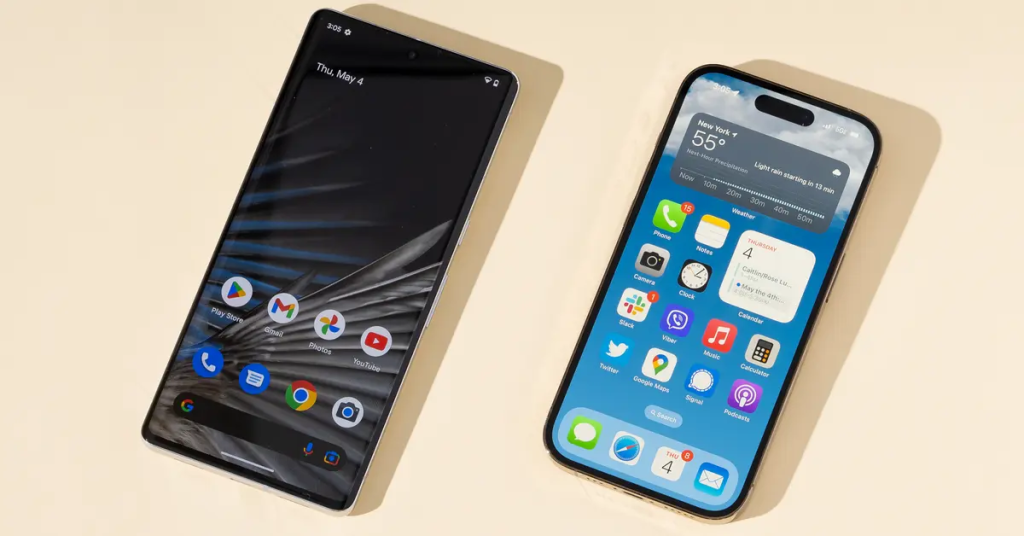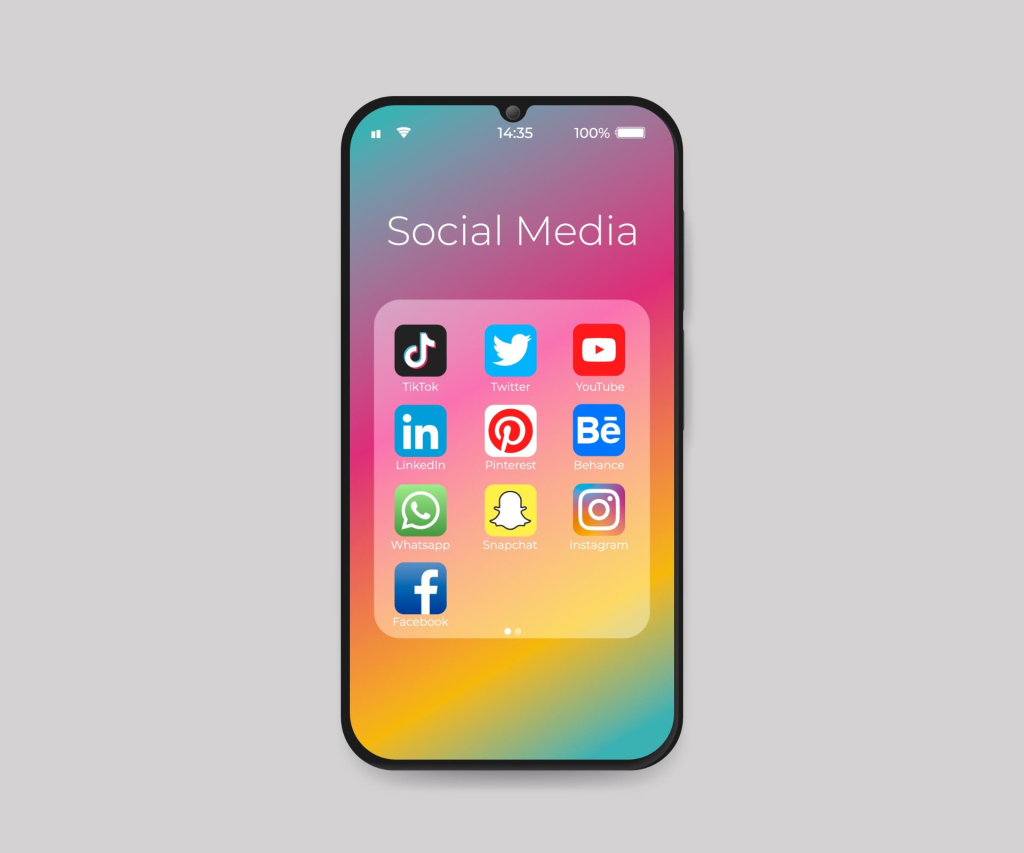Choosing the right smartphone for managing your business’s social media presence is a critical decision. For content creators, influencers, small business owners, and social media managers, the phone you use can impact the quality of your content, your productivity, and even your overall social media strategy. The two dominant platforms—iPhone (iOS) and Android—offer different features, advantages, and experiences, making it essential to determine which one best suits your business needs.

In this blog, we’ll dive into the key differences between iPhone and Android when it comes to social media management, helping you decide which platform is better for your business.
1. Camera Quality: A Critical Factor for Content Creation
For businesses that rely on social media, camera quality is a top priority. Whether you’re posting photos on Instagram, creating TikTok videos, or streaming live events, the quality of your visuals can make or break your engagement.
iPhone:
Apple has long been a leader in smartphone photography, with each new iPhone model improving its camera capabilities. The iPhone’s computational photography features like Deep Fusion and Smart HDR enhance photos automatically by improving color balance, sharpness, and lighting. Additionally, iOS consistently offers seamless integration with social media apps, ensuring photos and videos retain high quality when posted.
- Advantages:
- Superior photo and video quality, especially in low-light conditions.
- Consistent color accuracy and sharpness across apps.
- Easy-to-use editing tools built into the camera app.
- Better performance with apps like Instagram, which is often optimized for iOS.
Android:
Android phones, especially flagship models from Samsung, Google Pixel, and OnePlus, have caught up to the iPhone in camera quality, offering high-resolution sensors, night modes, and advanced editing features. However, the quality can vary significantly depending on the manufacturer and model.
- Advantages:
- Greater flexibility with manual camera settings for advanced users.
- High-end models like the Samsung Galaxy S23 Ultra and Google Pixel 8 Pro rival iPhone in terms of camera quality.
- More customizable camera apps with options for professional-grade photography.
Verdict: If your business relies heavily on content creation, especially for visual platforms like Instagram or TikTok, the iPhone tends to offer a more consistent and reliable camera experience across social media apps. Android can match iPhones in specific high-end models, but the experience is more varied depending on the brand.
2. App Optimization and Updates: Smooth Performance Matters
When it comes to social media, the user experience often depends on how well apps are optimized for your device. Smooth performance can help you post faster, interact with your audience more efficiently, and avoid frustrating crashes or glitches.
iPhone:
One of iPhone’s biggest advantages is that iOS offers a uniform environment for developers. This means that apps, including social media platforms like Instagram, TikTok, and Facebook, are often better optimized for iOS. Updates tend to roll out faster on iPhones because developers only need to cater to a limited range of devices. Apple’s tight hardware and software integration ensures seamless performance across apps.
- Advantages:
- Early access to app updates and new features.
- Consistent performance across different iPhone models.
- Better app optimization for social media platforms.
Android:
Android offers more flexibility and variety, but that can be a double-edged sword when it comes to app optimization. Developers must account for a wide range of devices with different hardware configurations, which can lead to inconsistent app performance. However, Android users benefit from more customization options and the ability to sideload apps not available in the official store.
- Advantages:
- Greater freedom for customization and use of third-party apps.
- Some Android devices, like Google Pixel, get quick updates and have good app optimization.
- Flexibility to download beta versions of apps or alternative social media clients.
Verdict: For businesses that need reliable, smooth performance with social media apps, the iPhone is generally the better choice due to superior app optimization and faster updates. Android offers more flexibility, but performance can be inconsistent depending on the device.

3. Ecosystem Integration: Seamless Workflow Across Devices
As a business owner or social media manager, managing content across multiple devices—laptops, tablets, and desktops—is common. Having a seamless workflow across your devices can save time and boost productivity.
iPhone:
One of Apple’s strongest advantages is its ecosystem integration. If you use a MacBook, iPad, or Apple Watch, your iPhone fits into the system seamlessly. Features like AirDrop, Handoff, and Universal Clipboard make it easy to transfer content, continue tasks between devices, and collaborate on social media posts or marketing materials.
- Advantages:
- Effortless transfer of files, photos, and videos between Apple devices.
- Continuity features that allow you to pick up tasks across devices without interruptions.
- Integration with iCloud, making it easy to access media and documents from any Apple device.
Android:
While Android offers some integration with Google services like Google Drive, Google Photos, and Google Workspace, it lacks the deep, seamless cross-device integration that Apple offers. That said, Android can work well within the Google ecosystem, especially if you use Google tools for your business.
- Advantages:
- Strong integration with Google services.
- Flexibility to use devices from different manufacturers.
- Access to cloud storage options like Google Drive and Dropbox for file management.
Verdict: If your business relies on multiple Apple devices, the iPhone offers unparalleled ecosystem integration, making it easy to manage content, files, and tasks across your devices. Android is more suitable for users heavily invested in the Google ecosystem or those who prefer to mix devices from different manufacturers.
4. Customization and Flexibility: Tailoring the Experience
Customization is important for business owners who want to tailor their phone’s interface and functionality to suit their needs.
iPhone:
Apple’s iOS is known for its simplicity and consistency, but it’s also more restrictive when it comes to customization. While iOS 17 has introduced some customizable features, like widgets and Focus modes, it still lacks the deep customization options available on Android.
- Advantages:
- User-friendly interface with minimal need for adjustments.
- Widgets and app customization options have improved, allowing for more personalization.
- Easy-to-use operating system with intuitive design.
Android:
Android is the go-to platform for users who want complete control over their phone’s interface and functionality. From home screen layouts to third-party launchers, Android allows you to customize almost every aspect of your device. This flexibility is useful for businesses that need to use specific tools or workflows that require unique setups.
- Advantages:
- Customizable home screens, widgets, and app layouts.
- Freedom to install third-party apps and launchers.
- Greater control over device settings and workflows.
Verdict: For businesses that prioritize simplicity and a smooth user experience, iPhone is the better option. However, if you need flexibility and deep customization, Android is the clear winner.
5. Security and Privacy: Protecting Your Business and Data
For businesses handling sensitive information or working with clients, security is paramount. Both iPhone and Android offer security features, but there are differences in their approaches.
iPhone:
Apple has a reputation for prioritizing privacy and security. With features like Face ID, App Tracking Transparency, and regular software updates, iPhone users enjoy strong security protections right out of the box. iOS’s closed system also limits the potential for malware and data breaches.
- Advantages:
- Robust built-in security features.
- Regular updates that ensure protection against the latest threats.
- Privacy-focused policies, including tracking controls and app permissions.
Android:
Android has improved its security features over the years, but its open system and wide range of devices can make it more vulnerable to malware and security breaches. That said, Android’s flexibility allows users to implement third-party security solutions or custom security protocols tailored to their needs.
- Advantages:
- Ability to use custom security software and solutions.
- Google Play Protect scans apps for security risks.
- Advanced users can install privacy-focused ROMs or secure custom builds.
Verdict: If security and privacy are a top priority for your business, the iPhone offers stronger out-of-the-box protection with regular updates and a privacy-centric approach. Android can be secure but often requires more manual intervention or third-party tools.

Which One Suits Your Business Better?
Choosing between an iPhone and an Android device for your business’s social media needs depends on several factors:
- If you prioritize camera quality, app optimization, and seamless integration across devices, the iPhone is likely the better choice. It’s an ideal platform for creators who need consistent performance and strong ecosystem support.
- If you value flexibility, customization, and integration with Google services, Android offers more options for tailoring your experience to fit your business’s specific workflows and needs.
Ultimately, both platforms have their strengths, and your decision should align with how you plan to use the device for your social media strategy, content creation, and business operations. You can also check out our content on-


